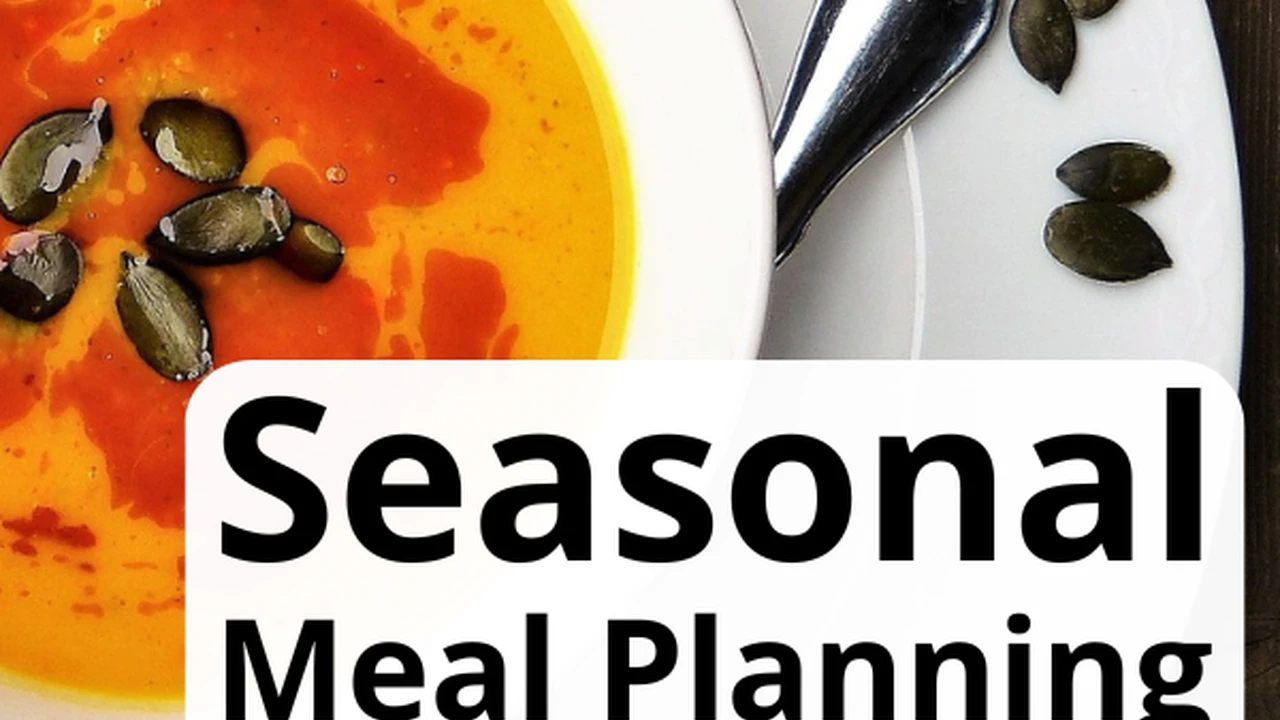Budget Friendly Seasonal Meal Planning Tips
Eat healthy on a budget with these seasonal meal planning tips. Discover how to save money while enjoying fresh, in-season produce.

Budget Friendly Seasonal Meal Planning Tips
Eat healthy on a budget with these seasonal meal planning tips. Discover how to save money while enjoying fresh, in-season produce.Hey there, health-conscious foodies! We all want to eat well, right? Fresh, nutritious meals that make us feel amazing. But let's be real, sometimes our wallets don't quite agree with our gourmet aspirations. Especially when you're trying to stick to seasonal eating, which, while often cheaper, can still add up if you're not smart about it. That's where budget-friendly seasonal meal planning comes in. It's not just about saving a few bucks; it's about maximizing your nutrition, reducing food waste, and making your grocery runs less stressful. We're going to dive deep into how you can master this, from smart shopping to clever cooking, and even throw in some product recommendations that won't break the bank.
Understanding Seasonal Eating Benefits and Cost Savings
First off, why seasonal? Beyond the obvious environmental benefits and supporting local farmers, seasonal eating is often your best friend when it comes to saving money. When produce is in season, it's usually more abundant, which drives down prices. Think about it: strawberries in summer are way cheaper and tastier than in winter. Plus, they're at their peak flavor and nutritional value. This means you get more bang for your buck, both in terms of taste and health. It also encourages variety in your diet, as you naturally rotate through different fruits and vegetables throughout the year.
Another huge benefit is freshness. Produce that's traveled thousands of miles out of season often loses nutrients and flavor. Buying in season means your food is likely fresher, tastes better, and lasts longer, reducing spoilage and food waste – another win for your budget!
Smart Shopping Strategies for Seasonal Produce
Okay, so you're convinced about seasonal eating. Now, how do you actually shop for it without overspending? It's all about strategy, my friend.
Farmers Markets vs. Supermarkets: Where to Find the Best Deals
This is a classic debate. Farmers' markets often have the freshest, most local produce. Sometimes, you can snag amazing deals, especially towards the end of the market day when farmers want to offload their remaining stock. Don't be afraid to ask about 'ugly' produce or bulk discounts. However, supermarkets can also be competitive, especially with their weekly sales flyers. My advice? Check both. Compare prices for in-season items. Sometimes, a supermarket's loss leader on corn in summer can beat a farmers' market price, but the quality might be better at the market. It's a balancing act.
Bulk Buying and Storage Tips for Seasonal Harvests
When something is in season and cheap, buy it in bulk! But don't just let it rot in your fridge. This is where smart storage comes in. For example, if berries are on sale, buy a lot, wash them, and freeze them for smoothies or baking later. Same goes for corn, peas, or even leafy greens (blanch and freeze!).
For root vegetables like potatoes, carrots, and onions, a cool, dark pantry is ideal. Apples and citrus can last a long time in the fridge. Knowing how to properly store different types of produce can significantly extend their shelf life and prevent waste.
Utilizing Sales and Discount Aisles Effectively
Always, always, always check the sales flyers before you go shopping. Plan your meals around what's on sale and what's in season. Don't go in with a rigid list if it means ignoring great deals. Also, keep an eye out for the 'reduced for quick sale' or 'manager's special' sections. You can often find perfectly good produce that just needs to be used within a day or two. This is perfect for immediate meal prep or freezing.
Meal Planning Techniques for Budget Conscious Eaters
Shopping smart is only half the battle. Planning your meals is where the real magic happens for your budget.
Weekly Meal Themes and Ingredient Repurposing
Instead of planning individual meals, think about meal themes. For example, 'Taco Tuesday' can use leftover roasted chicken from Sunday. 'Pasta Night' can incorporate leftover veggies. This helps you buy ingredients that can be used in multiple dishes, reducing waste and saving money. If you roast a big batch of seasonal vegetables like sweet potatoes and broccoli, they can be a side dish one night, added to a grain bowl the next, and blended into a soup later in the week.
Batch Cooking and Freezing for Future Meals
This is a game-changer. Dedicate a few hours on a weekend to cook large quantities of staple items. Cook a big pot of grains (quinoa, brown rice), roast a tray of vegetables, or cook a large batch of protein (chicken breast, lentils). Portion them out and freeze. This means you'll have healthy, homemade meals ready to go on busy weeknights, preventing expensive takeout orders.
Creating a Flexible Meal Plan Around Seasonal Availability
Don't be too rigid. Your meal plan should be a guide, not a strict rulebook. If you go to the market and find an amazing deal on zucchini, even if it wasn't on your list, be prepared to swap out another vegetable in your plan. Flexibility allows you to take advantage of unexpected savings and ensures you're always eating the freshest, most affordable produce.
Clever Cooking and Storage Solutions
Once you've got your seasonal haul, it's time to get cooking and make sure nothing goes to waste.
Maximizing Every Part of Your Produce: Root to Stem Cooking
Don't throw away those carrot tops! Or broccoli stems! Many parts of vegetables that we typically discard are perfectly edible and nutritious. Carrot tops can be made into pesto, broccoli stems can be peeled and roasted or added to stir-fries, and beet greens are delicious sautéed. This 'root to stem' approach not only saves money but also adds unique flavors and nutrients to your meals.
DIY Pantry Staples: Making Your Own Sauces and Broths
Store-bought sauces, dressings, and broths can be surprisingly expensive and often contain unnecessary additives. Making your own is cheaper and healthier. Use vegetable scraps (onion skins, carrot peels, celery ends) to make a rich vegetable broth. Blend seasonal tomatoes into a fresh pasta sauce. Make your own salad dressings with olive oil, vinegar, and herbs. It's easier than you think and tastes so much better.
Effective Food Storage Containers and Tools for Longevity
Investing in good food storage containers is crucial for preventing food waste. Airtight containers keep food fresher for longer. Glass containers are great because they're non-toxic and can go from fridge to microwave/oven. Vacuum sealers, while a bit of an upfront investment, can dramatically extend the life of frozen produce and meats.
Here are a few product recommendations that are budget-friendly and super useful:
- Rubbermaid Brilliance Food Storage Containers: These are fantastic. They're airtight, leak-proof, and come in various sizes. You can often find sets on sale. A 10-piece set might cost you around $30-40, but they'll last forever. Great for meal prepping and keeping leftovers fresh.
- Mason Jars: Seriously, these are multi-purpose heroes. Cheap, durable, and perfect for storing everything from homemade dressings to overnight oats, or even freezing berries. You can get a dozen for under $20.
- Stasher Reusable Silicone Bags: A bit pricier than Ziploc, but they're reusable, freezer-safe, microwave-safe, and dishwasher-safe. Great for storing chopped veggies, marinating meat, or even cooking sous vide. A starter set might be around $30-50, but they replace hundreds of single-use plastic bags.
- FoodSaver Handheld Vacuum Sealer: If you're serious about bulk buying and freezing, a handheld vacuum sealer is a more affordable entry point than a full-sized machine. It's great for smaller batches and extends freshness significantly. You can find these for around $50-70, plus the cost of bags.
Seasonal Recipes and Ingredient Swaps
Now for the fun part: cooking! Knowing how to adapt recipes to what's in season and on sale is key.
Flexible Recipes: Adapting to What's Available
Think of recipes as guidelines, not strict rules. If a recipe calls for spinach but kale is cheaper and in season, swap it! If it calls for chicken but pork shoulder is on sale, adjust accordingly. Learn basic cooking methods (roasting, sautéing, stewing) that can be applied to a variety of ingredients. A simple sheet pan roast can work with almost any combination of seasonal vegetables and protein.
Creative Ingredient Swaps for Cost Savings and Flavor
Don't be afraid to get creative. Can't afford pine nuts for pesto? Use walnuts or sunflower seeds. Out of fresh herbs? Dried herbs are a great, cheaper alternative. Instead of expensive cuts of meat, explore cheaper cuts that become tender with slow cooking, like chuck roast or chicken thighs. Lentils and beans are incredibly versatile, cheap, and nutritious protein sources that can stretch a meal further.
Utilizing Leftovers: From Dinner to Lunch Transformations
This is where your batch cooking and meal planning really pay off. Don't just reheat leftovers; transform them! Leftover roasted chicken can become chicken salad sandwiches, quesadillas, or a topping for a green salad. Leftover rice can be turned into fried rice or a base for a grain bowl. Leftover roasted vegetables can be added to omelets or blended into a soup. This prevents food boredom and ensures nothing goes to waste.
Budget Tracking and Financial Habits for Food
Finally, let's talk about the money side of things. You can't manage what you don't measure.
Tracking Your Grocery Spending: Apps and Spreadsheets
Know where your money is going. Use a simple spreadsheet, a budgeting app (like Mint, YNAB, or even just your bank's app if it has spending categories), or even just a notebook to track your grocery spending for a month. You might be surprised where your money is actually going. This awareness is the first step to making changes.
Setting Realistic Food Budgets for Different Seasons
Your food budget might fluctuate slightly with the seasons. In summer, when produce is abundant and cheap, you might spend less. In winter, when fresh produce is scarcer and more expensive, you might rely more on frozen staples or slightly higher-priced items. Set realistic budgets for each season based on your tracking. Don't beat yourself up if one month is slightly over; just learn from it.
Avoiding Impulse Buys and Sticking to Your List
This is probably the hardest part for many people. Impulse buys at the grocery store can quickly derail your budget. Stick to your list! If you see something tempting that's not on your list, ask yourself if you truly need it and if it fits into your meal plan. A good trick is to shop on a full stomach – you're less likely to buy unnecessary snacks or treats when you're not hungry.
By combining smart shopping, clever meal planning, and mindful cooking, you can eat incredibly well, enjoy the best of seasonal produce, and keep your budget happy. It's a journey, not a destination, so start small, experiment, and find what works best for you and your family. Happy cooking!
:max_bytes(150000):strip_icc()/277019-baked-pork-chops-with-cream-of-mushroom-soup-DDMFS-beauty-4x3-BG-7505-5762b731cf30447d9cbbbbbf387beafa.jpg)






